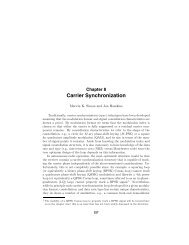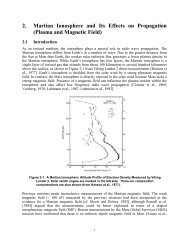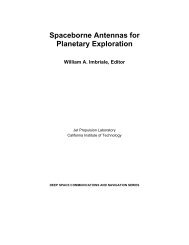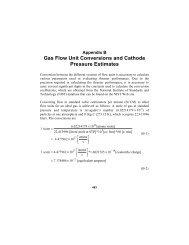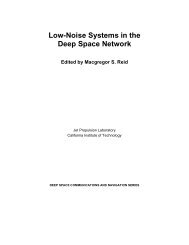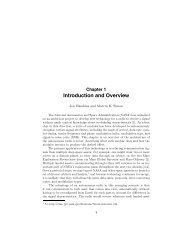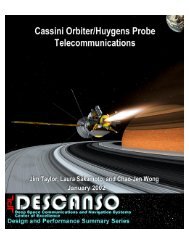Propagation Effects Handbook for Satellite Systems - DESCANSO ...
Propagation Effects Handbook for Satellite Systems - DESCANSO ...
Propagation Effects Handbook for Satellite Systems - DESCANSO ...
Create successful ePaper yourself
Turn your PDF publications into a flip-book with our unique Google optimized e-Paper software.
Figure 6.5-12 is an example <strong>for</strong> this expression, within the stated<br />
range of ~z/4, <strong>for</strong> an earth-space propagation path through a<br />
turbulent region of height 5 km. Note that Uez is directly<br />
proportional to path length and independent of operating frequency.<br />
Also,-oe decreases with increasing eddy size, 4 ~ while phase<br />
fluctuation Ue increases with increasing eddy size.<br />
Estimates (CCIR-1986b, Rpt. 564-3) indicate that the short-term<br />
variations in the angle-of-arrival may be of the order of 0.02<br />
degrees (0.37 milliradians) at 1 degree elevation. This is higher<br />
than the theory predicts (see Figure 6.5-12), but the effect does<br />
decrease rapidly with increasing elevation angle. Crane (1976)<br />
reports values of oe within the bounds of Figure 6.5-12 <strong>for</strong> 7 GHz<br />
measurements made at varying elevation angles with a 37 m diameter<br />
antenna.<br />
angles<br />
masked<br />
6.5.5<br />
Generally, <strong>for</strong> beamwidths greater than 0.01 degree and elevation<br />
above 10 degrees, the angle-of-arrival fluctuations are<br />
by other fluctuations.<br />
Fadinq and Gain Degradation Desiqn In<strong>for</strong>mation<br />
6.5.5.1 Fade Distribution Function Estimation. The estimates of<br />
gain reduction and signal variance parameters, R and S2, have been<br />
presented. These quantities may be incorporated into distribution<br />
functions which are of the <strong>for</strong>m used in link design. They represent<br />
the long term average fade statistics due to clear air amplitude and<br />
angle-of-arrival fluctuations. The estimates of R and Sz may be more<br />
closely matched to local and seasonal conditions if a local estimate<br />
of Cnz is available. A hypothetical low elevation angle fade<br />
distribution is presented in Figure 6.5-13. The abscissa is<br />
referenced to the signal level received in the absence of<br />
turbulence~ i.e.? including free space loss and gaseous absorption.<br />
The point at which the signal level is R dB is also the mean of the<br />
received signal; thus, one point on the fade distribution is<br />
established. The fade distribution <strong>for</strong> turbulence-induced<br />
fluctuations is assumed to be log-normal, with mean and median being<br />
6-95





